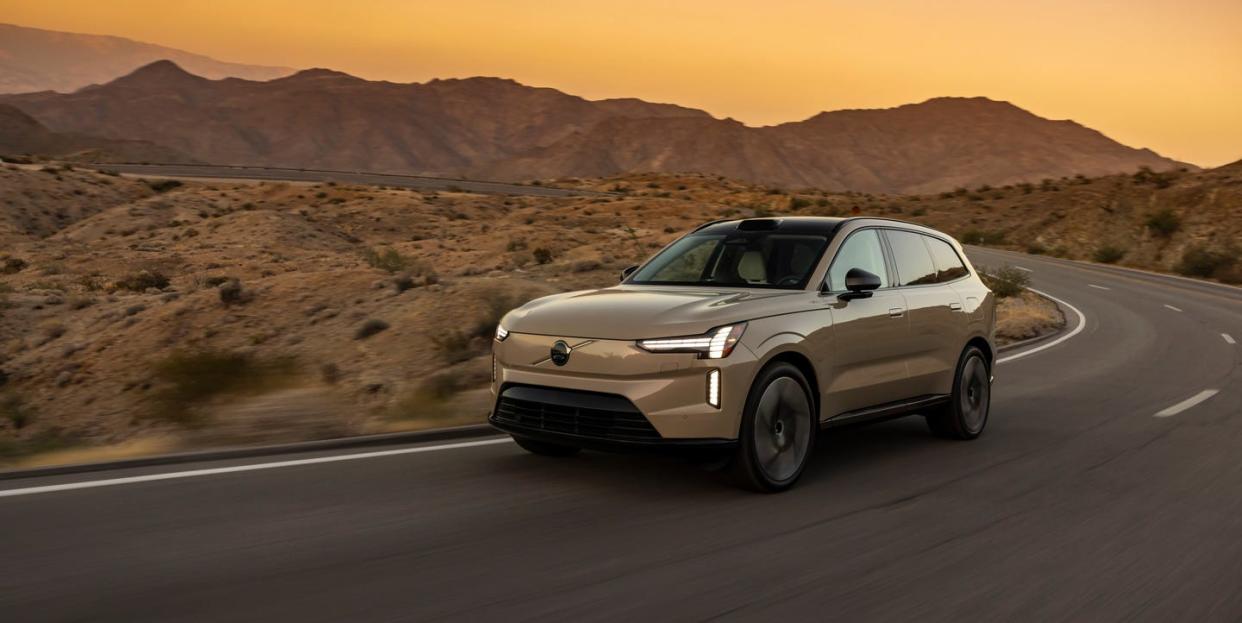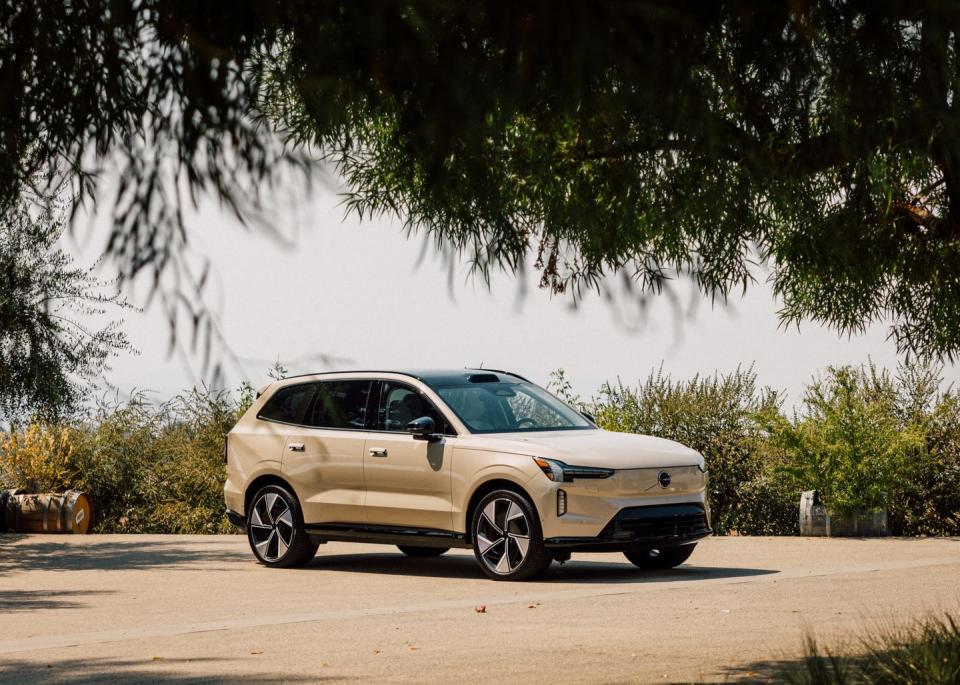Meet Volvo’s New £100,000 Seven-Seater

If you were born at some point during the last century, you may recall that once upon a time the things you bought were the things you bought and they did the things you bought them to do. Your TV was a TV and you watched TV on it. Your Discman was a Discman and you listened to music on it. And that was that.
Nowadays, of course, while the things we buy do still tend to do the things we buy them to do, in all likelihood they will at some point in the future do something more. Your phone, for example, will get a software update, and become a chess set. Or a light switch.
This doesn’t take much getting used to when it applies to your doorbell, but the same can’t quite be said when it’s your car. Your car moves. It’s heavy. And it will explode if you drive it into a wall. Messing with its brain doesn’t sound like a very good idea.
Or is it? Take Volvo’s new EX90, which I had the pleasure of driving in Los Angeles last week. It’s a very good car. Big, comfy, fast and full of tech that Volvo says won’t only keep you safe in an accident, but will do everything it can to make sure that accident doesn’t happen at all.

But what’s already most interesting about this car is what it doesn’t yet do that it might do one day, without anyone who owns one actually having to do anything at all. If I might explain. At some point, says Volvo, it will almost certainly send an over-the-air update that will make the EX90 autonomous. As in, self-driving. It can’t say when, but the hardware’s already in the car; it’s just that a cocktail of current legislation and Volvo’s reluctance to let it loose on the road until the software that runs it really is totally and utterly ready mean it’s not yet fully active.
And what that means is that if you buy an EX90 when it lands on a forecourt near you later this year, the car you buy won’t be a Discman, it’ll be an iPhone 16.
Which is quite something, isn’t it? Particularly when the car in question costs £100k. Imagine buying a pair of trousers that will hang around your ankles until the rules on trouser length change and the material tucked up in the hem can be released to make the trousers the best length they can be. Would you buy them?
Except, of course, the comparison is absurd. It’s also not quite right. Because for as long as a car is “software-driven”, a term now increasingly common in the automotive world, it will never be the best it can be. Theoretically, it will always be possible to add functions and performance, provided anyone can be bothered.

This isn’t just a Volvo thing. Tesla’s updates have improved the battery life and acceleration of its cars. But it’s still incredible. Forever, we’ve been used to our cars depreciating. Now they’re getting better while they sit outside in the rain.
For the mean time, the EX90 has to be judged on what it is now. Which is both the most expensive production car Volvo has ever made – and quite possibly the best.
At launch, there will be two models available: the Twin Motor Ultra at £96,255 and the Twin Motor Ultra Performance at £100,555. For those tidy sums, you’ll get a fully-electric seven-seater that runs on a 111kwh battery and that delivers a claimed 374 miles of “tailpipe-emission-free mobility”. The top-end model has 517 horsepower and a really quite quick 0-62mph time of 4.9 seconds. Both will have 22-inch alloys, a huge panoramic roof and a (fabulous) 25-speaker Bowers & Wilkins audio system.
Volvo says it will pad out the range at some point next year, adding an entry-level car with a single motor and a price tag of around £75,000. That’s still a lot for a Volvo: the much-loved and long-serving XC90 starts at a little over £60,000, which for now means you could get one of those and a Golf GTi before you’ve spent EX90 money. Even at £75k, that’s more than you’d pay for BMW’s vaunted iX, but then that doesn’t have seven seats.
The comparison isn’t entirely fair, though. Because the EX90 is a completely different car to the XC90. Not only does it have all that latent tech – which, incidentally, will be standard throughout the range in line with Volvo’s philosophy that we shouldn’t have to pay extra for safety features – it also has a new design and a new interior.
From side-on, the differences aren’t immediately clear, but the rear now has a sculpted sophistication about it, while the grill-less nose has a smooth, slightly amorphous profile. Inside, a mix of recycled and “bio-attributed material” has been moulded into space-age forms that feel clean and minimal, and delicious to the touch. Everything you’d expect of forward-looking Scandi design, in other words.
But even then, the story can’t help but veer back to the tech. One stat I heard during the media drive was that the car runs on Nvidia supercomputers that can handle up to 250 trillion commands per second. Which sounds like a lot.
Some of those will be linked to an interior radar system that detects heart rates so that the car won’t lock if you’ve left the family Lab in the boot while you pop into the shops. Which sounds nice and friendly, but could be a bit of a pain if you really are only just stopping for a pint of milk and don’t want a ne’er-do-well to steal your kids.
Then there’s the lidar (like radar, only with lasers) driver-understanding system, which tracks your eyes and your hands, so that the car will badger you like an old lady at a jumble sale should you look too long at the huge screen in the centre console or leave the lane-assist to steer the car for you for too long.
Some of the tech feels too much. For example, you have to tap-tap-tap (gah – where’s the sodding back button?) several layers down into the Google-powered touch-screen-operated user interface before you find the steering wheel column and wing mirror adjustment functions, although in mitigation Volvo says owners will only need to do this once or twice when they first get in their car, at which point those settings will become permanently allied to each driver’s key. The same can’t be said for the glove compartment though, which for reasons lost to logic is only openable via a screen-tap also buried deep in the system, to the despair of ergonomists everywhere.
But those minor gripes aside, Volvo has created a beautiful car that through the mountains that define the landscape south of Los Angeles provided a serene, intensely sophisticated driving experience. The power comes evenly and all but noiselessly, the driving position is just the right amount of superior and the cabin experience is more calming than a night-in with David Attenborough. And think what it will become… Frankly, I want one.
You Might Also Like


